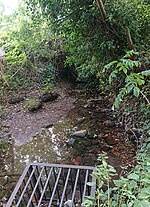Compton Halt railway station
Disused railway stations in WolverhamptonFormer Great Western Railway stationsPages with no open date in Infobox stationRailway stations in Great Britain closed in 1932Railway stations in Great Britain opened in 1925 ... and 3 more
Use British English from January 2018West Midlands (county) building and structure stubsWest Midlands (region) railway station stubs

Compton Halt was a small single platform halt on the Wombourne Branch Line. It was opened by the Great Western Railway in 1925 and closed in 1932. Poor patronage was a factor in the closure of the line and Compton Halt's existence was similarly blighted. Only the platform remains but is heavily overgrown and is partly decayed. The halt is now part of the South Staffordshire Railway Walk.
Excerpt from the Wikipedia article Compton Halt railway station (License: CC BY-SA 3.0, Authors, Images).Compton Halt railway station
South Staffordshire Railway Walk (The Track), Wolverhampton Compton
Geographical coordinates (GPS) Address Nearby Places Show on map
Geographical coordinates (GPS)
| Latitude | Longitude |
|---|---|
| N 52.5861 ° | E -2.1739 ° |
Address
South Staffordshire Railway Walk (The Track)
South Staffordshire Railway Walk (The Track)
WV3 9HP Wolverhampton, Compton
England, United Kingdom
Open on Google Maps



